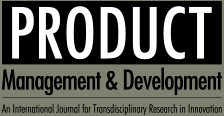Requirements management methods: does the literature need an update?
Carina Campese, Janaina Mascarenhas Hornos da Costa
Abstract
There are many models of Product Development Process in the literature. Although these models have different phases, all activities must be formally managed through methods and requirements management processes. Such methods are cited in several sources in the literature, but there is still a lack of application of them in Brazilian companies. This may be due to the lack of information on these methods, such as their step-by-step, examples and objectives. Thus, this study aims to analyze the methods of requirements management through content analysis (that followed three main phases: preparation, organising and reporting), highlighting the methods focused on User-Centered Design (a trend approach), helping in the choice of application of the methods by companies. From this analysis, it is concluded that the literature still lacks more detail on the application of the requirements management methods, as well as a greater attention to the user-oriented methods.
Keywords
References
ABRAS, C.; MALONEY-KRICHMAR, D.; PREECE, J. User-centered design. In: BAINBRIDGE, W. (Ed.). Encyclopedia of human-computer interaction. Thousand Oaks: Sage Publications, 2004. v. 37, n. 4, p. 445-456.
ALVES, I. et al. Aplicação do modelo e análise SWOT no diagnóstico estratégico de uma propriedade rural especializada em recria e engorda de bovinos de corte. Revista Administra-Ação, v. 4, p. 22-39, 2007.
ANDREASEN, M. M.; HANSEN, C. T.; CASH, P. Conceptual design: interpretations, mindset and models. New York: Springer, 2015. http://dx.doi.org/10.1007/978-3-319-19839-2.
AURUM, A.; WOHLIN, C. Engineering and managing software requirements. Berlin: Springer, 2005. http://dx.doi.org/10.1007/3-540-28244-0.
BAXTER, M. Projeto de produto: guia prático para o design de novos produtos. 2. ed. São Paulo: Edgard Blucher, 2000.
CARNEVALLI, J. A.; CAUCHICK MIGUEL, P. A. Empresas de referência na utilização do desdobramento da função qualidade. Revista Produto & Produção, v. 10, n. 1, p. 1-18, 2009.
CHEMUTURI, M. Requirements engineering and management for software development projects. New York: Springer, 2013. http://dx.doi.org/10.1007/978-1-4614-5377-2.
CLARK, K. B.; FUJIMOTO, T. Product development performance: strategy, organization, and management in the world auto industry. Boston: Harvard Business School Press, 1991.
CMMI INSTITUTE. CMMI® for development, version 1.3. Pittsburgh: Software Engineering Institute, 2010.
COOPER, R. G. Winning at new products: accelerating the process from idea to launch. 3th ed. Cambridge: Perseus Publishing, 2001.
CRAWFORD, C. M.; DI BENEDETTO, C. A. The new products management. 10th ed. New York: McGraw-Hill, 2010.
CREVELING, C. M.; SLUTSKY, J.; ANTIS, D. Design for Six Sigma in technology and product development. Upper Saddle River: Prentice Hall Professional, 2002.
ELO, S.; KYNGÄS, H. The qualitative content analysis process. Journal of Advanced Nursing, v. 62, n. 1, p. 107-115, 2008. http://dx.doi.org/10.1111/j.1365-2648.2007.04569.x.
HOGUE, J. A11y, Chatbots, and AI, Oh My! User-centered design trends for 2018. Providence: Oomph, 2018. Available from: <https://www.oomphinc.com/notes/2018/01/user-centered-design-trends-2018/>. Access in: 11 Mar 2018.
HOOD, C. et al. Requirements management: the interface between requirements development and all other systems engineering processes. Berlin: Springer, 2008.
KARAT, J. User centered design: quality or quackery? Magazine Interaction, v. 3, n. 4, p. 18-20, 1996. http://dx.doi.org/10.1145/234813.234814.
KAYO, R. O que é mapa de empatia e para que serve? 2015. Available from: <http://ramonkayo.com/conceitos-e-metodos/o-que-e-mapa-de-empatia-e-para-que-serve>. Access in: 7 July 2015.
MARQUES JUNIOR, L. J.; PLONSKI, G. A. Gestão de projetos em empresas no Brasil: abordagem “tamanho único”? Gestão & Produção, v. 18, n. 1, p. 1-12, 2011. http://dx.doi.org/10.1590/S0104-530X2011000100001.
MARX, Â. M.; PAULA, I. C. Proposta de uma sistemática de gestão de requisitos para o processo de desenvolvimento de produtos sustentáveis. Revista Produção, v. 21, n. 3, p. 417-431, 2011. http://dx.doi.org/10.1590/S0103-65132011005000041.
PAHL, G. et al. Engineering design: a systematic approach. 3th ed. New York: Springer, 2007. http://dx.doi.org/10.1007/978-1-84628-319-2.
PRESSMAN, R. S. Software engineering: a practitioner’s approach. 7th ed. New York: McGraw-Hill, 2010.
PUGH, S. Total design: integrated methods for successful product engineering. Wokingham: Addison-Wesley, 1991.
ROZENFELD, H. et al. Gestão de projetos em desenvolvimento de produtos. São Paulo: Saraiva, 2006.
ULRICH, K. T.; EPPINGER, S. D. Product design and development. 5th ed. McGraw-Hill, 2012.
VIITANIEMI, J. et al. Integration of user-centred design and product development process within a virtual environment. Finland: VTT Technical Research Centre of Finland, 2010.

